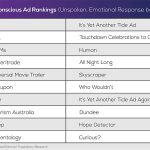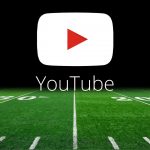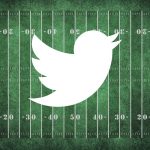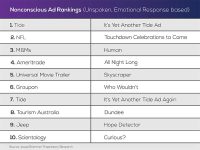A CMO’s View: How SunTrust Bank is maximizing its Super Bowl 50 campaign
Susan Somersille Johnson shares why her brand decided to be a Super Bowl 50 advertiser and the steps it’s taking to extend its OnUp Movement.

This year, more than 45 advertisers put their brand front and center at Super Bowl 50. SunTrust Banks, Inc. was one of those brands, entering game day as a first-time Super Bowl advertiser.
Building a campaign around its OnUp.com Movement, SunTrust’s aim was to launch a national conversation around financial well-being.
In addition to its 30-second “Hold Your Breath” spot that aired during the two-minute warning in the fourth quarter, SunTrust released a teaser ad on January 26, and a 60-second extended ad of its official spot the week of Super Bowl.
The campaign resulted in more than 10 million social media impressions and 38,000 OnUp.com site visits on game day. Since the campaign’s launch, SunTrust says it has generated more than 530 earned media placements, and its site has had more than 500,000 unique visitors, with more than 137,000 OnUp.com subscribers.
For today’s CMO’s View column, SunTrust Banks’ Susan Somersille Johnson shares why her brand chose to launch its OnUp Movement at Super Bowl and the steps it is taking to extend the campaign through the end of the year.

Susan Somersille Johnson
CMO @ SunTrust Banks, Inc.
Takeaways:
1. Have a message that matters.
2. Create a fully integrated campaign.
3. Begin the campaign internally: A Super Bowl ad can be a great sense of pride for employees, and you need to let everybody participate.
Amy Gesenhues: Before we get into SunTrust’s Super Bowl 50 campaign, can you tell me more about your team and your focus as the brand’s CMO?
Susan Somersille Johnson: We have a mantra here, “Brand and Demand, Brand and Demand.” My goal is to help build this iconic American brand and to drive demand at the same time. I think they can be done hand-in-hand.
My team is working on brand and demand. My group is comprised of the consumer marketing team, our commercial marketing team, also brand, digital, analytics, communications, and also we have a purpose team, unlike a lot of companies — all of that is under marketing.
Amy Gesenhues: What is the purpose team?
Susan Somersille Johnson: That is to make sure that we fulfill our purpose as a company. We committed to our purpose three years ago — We decided we would become a purpose-driven company. Our business is lighting the way to financial well-being. The purpose team helps to coordinate and guide, and make sure we’re living that every day.
I would say purpose is the internal way to talk about what we do. It’s the why of what we do. Are you familiar with Simon Sinek’s TED talks? The movement is the external representation of that.
It’s how we express what we do, to people outside of SunTrust, and how we make it real, guiding them from financial stress to financial confidence.
Amy Gesenhues: SunTrust Banks’ OnUp Movement was the focus of your Super Bowl 50 campaign. What was your target audience, and how was it different from previous SunTrust campaigns?
Susan Somersille Johnson: We’re constantly looking for ways to live and breathe our purpose, so this year we decided to launch a movement, which is a big deal, especially at our industry. We decided we’d launch this national movement called OnUp — for onward and upward — the goal is to inspire millions of Americans to really make a commitment to gain control of their finances and to take a step.
The whole goal of the campaign is to get the conversation started and to get people to take a step toward financial confidence.
It is really different from anything we’ve done before. This is not business as usual for us. The way that I like to explain it, I like to compare a campaign versus a movement, because it’s much larger than a marketing campaign. I would say a campaign is based on insights you have around your brand. We’re all very familiar with this. You determine what you want to say about your brand and then you find a creative way to tell people about that.
This movement is based on insights [into] the problem of financial stress. We talked to over 190,000 people, and we talked to over 8,000 businesses about financial stress, and that’s the basis of the movement.
The second difference between a campaign and a movement is a campaign is all about eyeballs. It’s all about reach. A movement will spread more based on word-of-mouth than a typical campaign, although you try to do both. Word-of-mouth is everything for a movement, and because we interviewed so many people, we know that this is a topic that will, and has, taken off.
Then the last, and I think most important, difference with a movement is that it’s all about partners. So it’s not just about a single brand — We have several partners on board with us with this movement. Operation Hope is one of those, and United Way. We have several partners with us on this journey. That’s key for spreading a movement.
Amy Gesenhues: Can you talk more about the decision to launch the campaign at this year’s Super Bowl?
Susan Somersille Johnson: As you can imagine, we labored long and hard over this decision. We’re a first time Super Bowl advertiser, so it’s a big decision as well.
The way I see it, all Super Bowl brands either have something to say or something to sell. In our case, this time, we had something to say. We knew that we had something that taps into the pulse of the nation right now. We looked very analytically. We looked at how you get the best reach — and the Super Bowl was one of the most, if not the most, effective ways to reach the most people possible with this message.
You asked about our target before — Our target isn’t so much a demographic as a state of mind. Our target is people that are leaning into their finances, people that value advice, people that are motivated, driven, and Super Bowl is the best way to reach those people.
Amy Gesenhues: I know one of your goals around the OnUp Movement was to spark a national conversation. Can you can give me examples of where you have seen this happening?
Susan Somersille Johnson: Oh yeah, it’s been really fun to watch the conversation spread.
As a first-time advertiser, we weren’t sure what traffic to expect. We talked to some of our peers, some veteran advertisers. The traffic we got the night of the Super Bowl was comparable to what veteran advertisers get. That was the first indication we were on the right track.
Then came the results of the sentiment, the night of the Super Bowl. SunTrust tied for No. 1 positive sentiment, based on listening tools.
Our campaign has just started — I think we’re 100 days in. It’s really too early to claim success. On the game day, we had over 10 million social media impressions. Since then, millions more have viewed the ad.
We think the message is spreading. Then, there’s a lot of anecdotal information that we’re getting. When you talk about people’s finances and money, you get a lot of personal stories. Now we’re getting stories of people going to their kids’ soccer teams to talk about it, the parents’ groups, the community groups, they’re going to their churches. Some of our teammates have plans to talk to their churches.
It’s spreading in ways we can’t even imagine, and that’s exciting because it’s a movement, so we don’t know which way that it’s going to go. As of today, 137,000 people have actually joined the movement. That’s above our expectations, and we’re really exited about that.
Amy Gesenhues: When you say “join the movement,” do you mean they’ve become customers?
Susan Somersille Johnson: We want to offer financial advice to everybody, not just customers, so joining the movement means you’ve taken a step towards financial confidence. We track that on OnUp.com, we have a running ticker at all times on OnUp.com of people who have taken a step towards financial confidence.

Many are not clients; we hope they will be one day, but basically you just go there and you get a lot of tips and advice. That’s a great question, though. I should also mention an important early indicator of our financial performance; we just recently announced our results for the first quarter, and our financial performance beat expectations.
Now, of course, you don’t know all the things that contributed to that, right? There are ups and downs in our industry, but again, it’s another sign that we’re moving in the right direction.
Amy Gesenhues: Beyond the OnUp.com website, what other channels are you using to reach people and help promote the movement?
Susan Somersille Johnson: February 7 was the launch of the movement, and also the launch of the campaign, so I made the distinction between the two. It’s a completely integrated campaign that will run throughout the year.
We have cycles where we’ll run ads heavier than others, but it crosses a regional broadcast. So we do television — NCAA Final Four, “The Walking Dead,” all types of different shows to target primarily Millennials. We also did some cinema; we did some high impact digital; we did some billboards, paid search — pretty much the whole mix.
Native advertising is performing exceptionally well for us. I think it’s because of the content. It goes back to what I mentioned; we have something to say, not necessarily sell. We’re literally not selling anything on the site. People are searching for top 10 ways to lower my debt or whatever, and they get our native content, and they’re clicking through. Native is working really well for us here.
Amy Gesenhues: What are the challenges when it comes to keeping the momentum of a campaign that launches so early in the year?
Susan Somersille Johnson: We like to say here, “Measurement drives momentum.” That’s why, right on the front page of OnUp.com is our measurement. It is a constant reminder to us we need to move forward quickly.
Some of this is trial and error. We’re trying to get messages out there that will work. We have a number of social media activations that we’ll be doing through the year. One of the things we just started is Millennial Money Talk. It’s a series of conversations with teammates, employees of ours, Millennials who have been through financial challenges.
Amy Gesenhues: Is that a podcast?
Susan Somersille Johnson: Right now, it’s just content, and we’ve just started to reach out to media outlets to see what the interest is in covering the content. It’s still in the idea phase. We have some really powerful personal stories of people who have gotten through challenges, so we’re trying to find out ways to share them. That’s one thing that we’re doing.
We’re doing a lot of grassroots activations. We’re at Major League Baseball and NFL teams that we sponsor, we’re at the stadium doing on-site activations, so a lot of grassroots efforts there.
Last month, we launched our financial fitness for companies program, which will be one of the hallmarks of the movement. This is a program to help employees of companies become financially fit. Since it’s so ingrained in what we do, I think it really helps keep the movement going.
It started last year. Last February, we had to do some financial fitness of our own. We’re a bank, and we surveyed our teammates, and most of them did not feel financially confident. We used one of the leading financial fitness providers for our companies, and then we bought the intellectual property from that company and decided to offer it to other companies at no profit to us this year.
We just went into pilot with that, and we have a lot of companies that want to take advantage. We think as we launch more and more companies on that, it’s going to help keep the movement going, too.
Amy Gesenhues: Before we end, I’m curious. Is there anything you would have done differently as a first-time Super Bowl advertiser?
Susan Somersille Johnson: I think the key learning we had was to release the ad early. I think about half of the ads are released before the Super Bowl. We debated that, and the amount of coverage, we ended up with 530 media placements.
That’s a result of releasing early. Even if you don’t want to release your spot early, release a teaser or something like that. It was critical to our coverage, and we had not planned that.
We fortunately, about a week before, decided to go ahead and do it. But we hadn’t planned that, and I would have if I had it to do over.
Marketing Land – Internet Marketing News, Strategies & Tips
(55)














